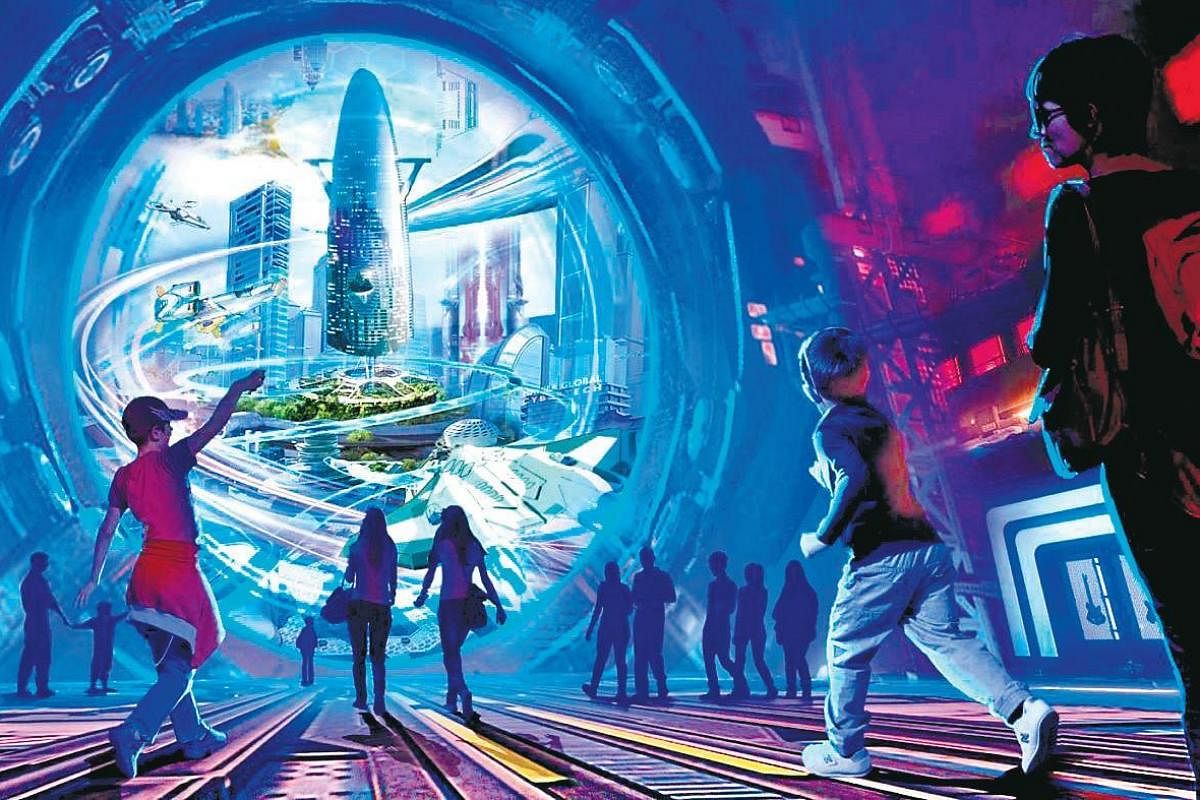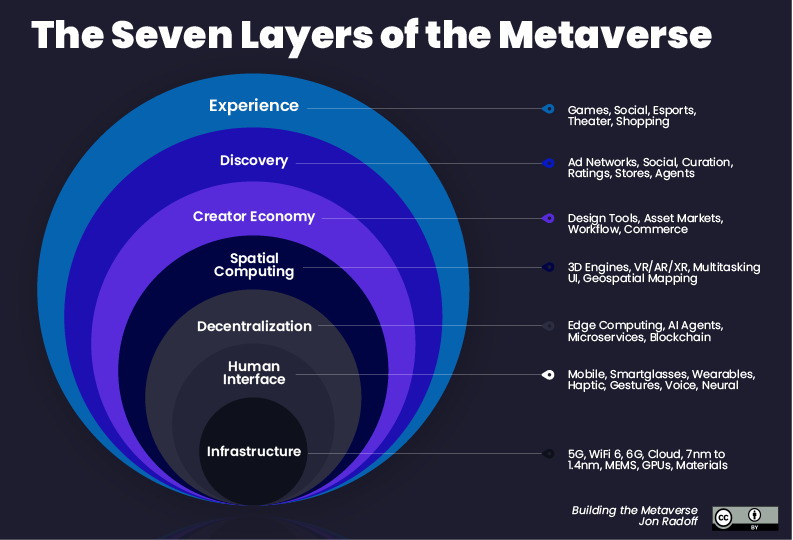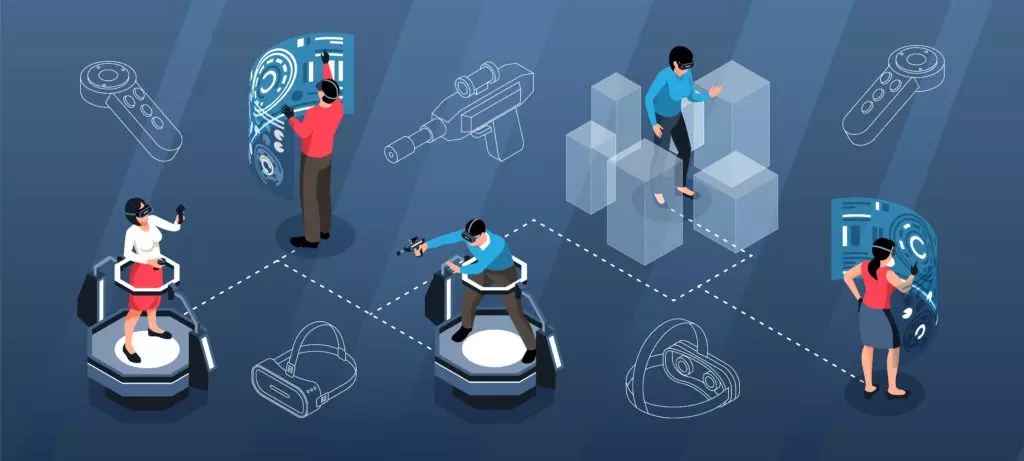Comments
- No comments found

The metaverse has been a hot topic of conversation recently, with many tech giants like Facebook and Microsoft staking claims.

Source: Jon Radoff
Author Neal Stephenson is credited with coining the term "metaverse" in his 1992 science fiction novel "Snow Crash". He envisioned lifelike avatars who live in realistic 3D buildings and other virtual reality environments. Correspondingly, in a technical sense, metaverse is another name for the Internet of Everything (IoE), a concept started in the early 2000s, leading to the internet of things (IoT) and its applications a scaled-down version of the IoE. Since then, various developments have made milestones on the way toward a real metaverse, an online virtual world that incorporates augmented reality (AR), virtual reality (VR), 3D holographic avatars, video, and other means of communication. As the metaverse expands, it will offer a hyper-real alternative world or what Comic fans call the parallel universe. But this description is like talking about "Frontend "in app development only without explaining the "Backend" side of the apps. To understand that side of this new X-verse, we need to look at Metaverse from a different perspective.

The metaverse "is bringing together people, processes, data, and things (real and virtual) to make networked connections more relevant and valuable than ever before-turning information into actions that create new capabilities, richer experiences, and unprecedented economic opportunity for businesses, individuals, and countries". In simple terms, the metaverse is the intelligent connection of people, processes, data, and things. It describes a world where billions of objects have sensors to detect, measure, and assess their status, all connected over public or private networks using standard and proprietary protocols. The main pillars of the metaverse, as depicted in the figure above, are:
People: connecting people in more relevant, valuable ways;
Data: converting data into intelligence to make better decisions;
Processes: delivering the right information to the right person (or machine) at the right time;
Things: physical and virtual devices and objects connected to the Internet and each other for intelligent decision-making.

Source: IDTechex
No new technologies or concepts come without challenges, and the metaverse is no exception:
Identity Management: it is difficult to confirm ID in current Web 2.0 apps; with metaverse, the problem scales up as we expand the use of the products and services; the last thing you want is to create a wild west in metaverse.
Security, Safety, and Privacy (SSP): As devices/people get more connected and collect more data, accelerating the metaverse expansion at a speed close to the speed of the real universe, privacy, safety, and security concerns will increase too. How companies decide to balance customer SSP with this wealth of metaverse data will be critical for the future of the Metaverse and, more importantly, customers' trust in the metaverse and any future X-verse versions.
Finance in Metaverse: using cryptocurrency is a challenge by itself; using it as a way of payment in metaverse will add more complications to what is still an unregulated payment system, one of the options to overcome this is to consider CBDC (Central Bank Digital Currency).
Laws, Regulations, and Protections: new world and new territory for the law to explore and define the responsible parties and create new regulations to protect everyone using metaverse, including Intellectual Properties with the newfound businesses like NFTs.
The Emotional and Mental Impact of Living in the Metaverse: the same issues of non-stop social media usage and online gaming will transfer to the Metaverse on a large scale with another dimension added with near real-time interactions, this could create a lot of mental issues in the real world, and the line between real and imaginary world will be blurred with actions and words used in both worlds.
Standardization of the Metaverse: this is usually one of the toughest parts in the early lifecycle of any new technology as everyone wants to be the "standard" and dominate the market; standards will cover all hardware/software, processes, protocols and make interoperability fundamental to the design and implementation of the metaverse.
Data is embedded in everything we do; every business needs its flavour of data strategy, which requires comprehensive data leadership. The metaverse will create tens of millions of new objects and sensors, all generating real-time data which will add more value to their products and services for all the companies who will use metaverse as another avenue of business. As a result, enterprises will make extensive use of metaverse technology. As a result, there will be a wide range of products sold into various markets, vertical and horizontal, an endless list of products and services.
For example, in e-commerce, the metaverse provides a whole new revenue stream for digital goods in a synchronous way instead of the current traditional 2D way of clicking and buying. In human resources (HR), significant training resources will be done with virtual reality (VR) and augmented reality (AR) that are overlaying instructions in a real-world environment and giving somebody a step-by-step playbook on how to put a complex machine together or run a device or try a new product all will be done with virtual objects at the heart of the Metaverse. While in sales/marketing, connecting with customers virtually and sharing the virtual experience of the product or service will be common similar to our virtual meetings during the past two years in the middle of Covid, but the Metaverse will make it more real and more productive. Crypto products, including NFTs, will be the natives of the Metaverse, adding another block to the Web 3.0 puzzle.
The pandemic forced us to be more online and accept many actions to be virtual, which was like a preview for the metaverse in 2D; the real metaverse is 3D with time as the 4th dimension. Still, in the metaverse, we control time and space because we create both in the metaverse.
Finally, similarly to cloud computing, we will have private-metaverse, hybrid-metaverse, and public-metaverse with all possible applications and services in each type. Companies will benefit from all options based on their capabilities and needs. The main goal here is to reach metaverse as a service (MaaS) and see a label of "metaverse certified "on products and services.
Ahmed Banafa is an expert in new tech with appearances on ABC, NBC , CBS, FOX TV and radio stations. He served as a professor, academic advisor and coordinator at well-known American universities and colleges. His researches are featured on Forbes, MIT Technology Review, ComputerWorld and Techonomy. He published over 100 articles about the internet of things, blockchain, artificial intelligence, cloud computing and big data. His research papers are used in many patents, numerous thesis and conferences. He is also a guest speaker at international technology conferences. He is the recipient of several awards, including Distinguished Tenured Staff Award, Instructor of the year and Certificate of Honor from the City and County of San Francisco. Ahmed studied cyber security at Harvard University. He is the author of the book: Secure and Smart Internet of Things Using Blockchain and AI.
Leave your comments
Post comment as a guest